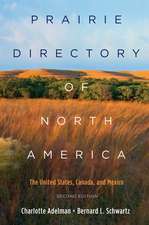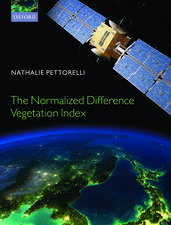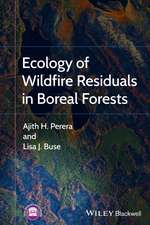Predictive Species and Habitat Modeling in Landscape Ecology: Concepts and Applications
Editat de C. Ashton Drew, Yolanda F. Wiersma, Falk Huettmannen Limba Engleză Paperback – 13 oct 2014
Due to the inherent use of GIS for much of this kind of research, and as several authors’ research involves the production of multicolored map figures, there would be an 8-page color insert. Additional color figures could be made available through a digital archive, or by cost contributions of the chapter authors. Where applicable, would be relevant chapters’ GIS data and model code available through a digital archive. The practice of data and code sharing is becoming standard in GIS studies, is an inherent method of this book, and will serve to add additional research value to the book for both academic and practitioner audiences.
| Toate formatele și edițiile | Preț | Express |
|---|---|---|
| Paperback (1) | 1381.58 lei 6-8 săpt. | |
| Springer – 13 oct 2014 | 1381.58 lei 6-8 săpt. | |
| Hardback (1) | 1386.48 lei 6-8 săpt. | |
| Springer – 30 noi 2010 | 1386.48 lei 6-8 săpt. |
Preț: 1381.58 lei
Preț vechi: 1684.85 lei
-18% Nou
Puncte Express: 2072
Preț estimativ în valută:
264.40€ • 287.10$ • 222.09£
264.40€ • 287.10$ • 222.09£
Carte tipărită la comandă
Livrare economică 23 aprilie-07 mai
Preluare comenzi: 021 569.72.76
Specificații
ISBN-13: 9781489981356
ISBN-10: 1489981357
Pagini: 328
Ilustrații: XIV, 313 p.
Dimensiuni: 152 x 229 x 17 mm
Greutate: 0.46 kg
Ediția:2011
Editura: Springer
Colecția Springer
Locul publicării:New York, NY, United States
ISBN-10: 1489981357
Pagini: 328
Ilustrații: XIV, 313 p.
Dimensiuni: 152 x 229 x 17 mm
Greutate: 0.46 kg
Ediția:2011
Editura: Springer
Colecția Springer
Locul publicării:New York, NY, United States
Public țintă
Professional/practitionerCuprins
Acknoweldgements.- Forword by Jack Liu.- List of Contributors.- List of abbreviations.- Introduction.- Chapter 1. Landscape modeling of species and their habitats: history, uncertainty, and complexity (by Yolanda Wiersma, Ashton Drew, Falk Huettmann).- Section 1. Current State of Knowledge.- Chapter 2. Integrating Theory and Predictive Modeling for Conservation Research (by Jeremy T. Kerr, Manisha Kulkarni, and Adam Algar).- Chapter 3. The State of Spatial and Spatio-Temporal Statistical Modeling (by Mevin B. Hooten).- Section 2. Integration of Ecological Theory into Modeling Practice.- Chapter 4. Proper Data Management as a Scientific Foundation for Reliable Species Distribution Modeling (by Benjamin Zuckerberg, Falk Huettmann, and Jacqueline Frair).- Chapter 5. The Role of Assumptions in Predictions of Habitat Availability and Quality (by Edward J. Laurent, C. Ashton Drew, Wayne E. Thogmartin).- Chapter 6. Insights from Ecological Theory on Temporal Dynamics and Species Distribution Modeling (by Robert J. Fletcher, Jr., Jock S. Young, Richard L. Hutto, Anna Noson, and Christopher T. Rota).- Section 3. Simplicity, Complexity, and Uncertainty in Applied Models.- Chapter 7. Focused Assessment of Scale-Dependent Vegetation Pattern (by Todd R. Lookingbill, Monique E. Rocca, and Dean L. Urban).- Chapter 8. Modeling Species Distribution and Change Using Random Forest (by Jeffrey S. Evans, Melanie A. Murphy, Zachary A. Holden, and Samuel A. Cushman).- Chapter 9. Genetic Patterns as a Function of Landscape Process: Applications of Neutral Genetic Markers for Predictive Modeling in Landscape Ecology (by Melanie A. Murphy and Jeffrey S. Evans).- Chapter 10. Simplicity, Model Fit, Complexity and Uncertainty in Spatial Prediction Models Applied Over Time: We Are Quite Sure, Aren’t We? (by Falk Huettmann and Thomas Gottschalk).- Chapter 11. Variation, Use, and Mis-use of Statistical Models: a Review of the Effects on the Interpretation of Research Results (by Yolanda F.Wiersma).- Chapter 12. Expert Knowledge as a Basis for Landscape Ecological Predictive Models (by C. Ashton Drewand Ajith H. Perera).- Section 4. Designing Models for Increased Utility.- Chapter 13. Choices and Strategies for Using a Resource Inventory Database to Support Local Wildlife Habitat Monitoring (by L. Jay Roberts, Brian A. Maurer, Michael Donovan).- Chapter 14. Using Species Distribution Models for Conservation Planning and Ecological Forecasting (by Josh J. Lawler, Yolanda F. Wiersma and Falk Huettmann).- Conclusion.- Chapter 15. The state of habitat and species modeling today (by Ashton Drew, Yolanda Wiersma, Falk Huettmann).
Textul de pe ultima copertă
Much research in landscape ecology makes use of spatial models to define species-habitat associations. The early years of landscape ecology necessarily focused on the evolution of effective data sources, metrics, and statistical approaches that could truly capture the spatial and temporal patterns and processes of interest. Now that these tools are well established, we reflect in this volume on the ecological theories that underpin the assumptions commonly made during species distribution modeling and mapping. This is crucial for applying models to questions of global sustainability. This book will offer a unique perspective on modeling within the discipline of landscape ecology, which complements that of other recent publications. Through chapters that focus on particular aspects of modeling, illustrative case studies, and surveys of the field of modeling, this book illustrates that we can (and need to) pay attention to the foundational ecological theories and assumptions which support model development. We show how this can be done in modeling through theory, traditional inference, and predictions. Chapter authors have attempted to critically identify, evaluate, and even formally test these ecological theories and have also written thoughtful reflections on the state of landscape-scale species/habitat modeling. Predictive Species and Habitat Modeling in Landscape Ecology: Concepts and Applications is intended to be useful to researchers in landscape ecology, as well as those in conservation biology, wildlife management, population and community ecology, and general ecology. The book will be a valuable resource for graduate students incorporating landscape ecology and/or species modeling in their degree programs.About the EditorsC. Ashton Drew is a postdoctoral researcher in the USGS North Carolina Cooperative Fish and Wildlife Research Unit, North Carolina State University. Her research interests focus on how models can support adaptive monitoring and management.Yolanda F. Wiersma is Assistant Professor in Biology at Memorial University (Canada). She conducts research in Boreal Landscape Ecology, with a focus on models of wildlife-habitat interactions, forestry and protected areas. Falk Huettmann is Associate Professor in the Biology and Wildlife Department, Institute of Arctic Biology, University of Alaska-Fairbanks. His research interests are in wildlife/habitat modeling, GIS and remote sensing, and data management worldwide.
Caracteristici
Highlights how fundamental ecological theories are being explicitly integrated into the model building processes offers practical examples of how modelers are addressing the conflict between the complexity of ecological systems and the relative simplicity of their modeled systems Presents novel prediction methods to identify and quantify sources of uncertainty and variability in species habitat associations in time and space












